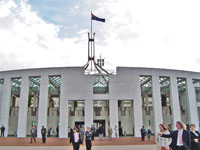We're back now for day three of the conference, following the lavish dinner at New Parliament House last night. Robin Dale from the Research Libraries Group begins the day's proceedings, which focus this morning on the topic of collaboration. She points out that in the current environment collaboration is increasingly important, and in such collaborations, the issue of mutual trust, and trust in the content repositories, becomes particularly crucial. How can trust be established, and trustworthiness assessed?
One indicator may be the repository's organisational model (centralised vs. decentralised), which may have an effect on the sustainability of the repository. Neither model is necessarily better than the other; this depends also on the aims of the repository, of course (and on available funding). Decentralisation especially builds on trusted alliances, of course, while centralisation means that this central repository needs to be inherently trustworthy. The problem is that trust cannot be designed, but is built little by little, over time.
Perhaps it would be appropriate, then, to develop a certification process for digital repositories which enable and signal trust in their operations. Certification could dictate certain criteria of operation, and establish a known set of best practices; it could question and verify assumptions about commitment, capabilities, behaviour, and sustainability, and check for the fail-safe mechanisms in place at an institution.
Next up is Beth Dulabahn from the Library of Congress, speaking on the National Digital Information Infrastructure and Preservation Program (NDIIPP). It is a federally supported program in the U.S., with a significant level of funding attached to it. Its goal is to develop a national digital collection and preservation strategy, and in doing so work with all relevant stakeholders in the field (including also commercial sectors such as music and movie producers and publishers).
NDIIPP takes an iterative approach of learning by doing, building on existing systems. Its main areas are preservation architecture (which must be interoperable - Clay Shirky is a key driver of this area), digital preservation research, and building a network of partners, all of which also deal with a broad diversity of content from online material to digital broadcasting and beyond. Various projects are now underway as part of NDIIPP; at the end of its 5-year lifespan the project should have established a network of 50-75 partners and a vast archive of at-risk content.
Last is Warwick Cathro, the Assistant Director-General of the NLA. His topic is preserving the outputs of research, and he begins by identifying what such outputs might be (from primary outputs such as data sets, images, and recordings to secondary outputs such as research papers and presentations). Much of this content is at risk because of insufficient backup and preservation strategies within academic institutions; indeed many academics are unaware of the need for long-term preservation of research outputs.
There are some institutional repositories which have emerged in response to such problems, and only these may be able to provide a comprehensive solution (some software tools include e-prints, DSpace, and Fedora, for example). E-prints in particular is now also being used in various Australian universities. In the UK, a Digital Curation Centre has been set up to deal with similar issues, while in Australia there is the Systemic Infrastructure Initiative and (as part of it) the Australian Partnership for Sustainable Repositories. Once again, collaboration is key here, and university libraries may play an important (but challenging) role in this. National libraries, on the other hand, may be better able to act as stewards of the process as it is undertaken by the partners in such projects.













